MHD Mixed Convection in a Lid-Driven Cavity with a Bottom Trapezoidal Body: Two-Phase Nanofluid Model
Abstract
:1. Introduction
2. Mathematical Formulation
3. Numerical Method and Validation
4. Results and Discussion
5. Conclusions
- At a high Richardson number when the natural convection is dominant, thermophoresis can produce a homogeneous dispersion of nanoparticles.
- The convection heat transfer enhances with the nanoparticle volume fraction and is affected by increments in the thermal conductivity and thermophoresis. In contrast, at a high Richardson number, a boost in the nanoparticle volume fraction that exceeds 0.035 leads to a reduction in the average Nusselt number.
- A cavity with small trapezoidal solid body and low magnetic field tends to show more enhancement on the rate of heat transfer. However, imposing a high magnetic field in a cavity with a big trapezoidal solid body leads to the best improvement in convection heat transfer.
- A strong enhancement of the average Nusselt number occurs with a high nanoparticle volume fraction and a relatively small trapezoidal solid body.
- Thermophoresis and Brownian motion effects play significant roles in the augmentation of convection heat transfer.
Author Contributions
Funding
Acknowledgments
Conflicts of Interest
Abbreviations
| applied magnetic field | |
| magnitude of magnetic field | |
| specific heat capacity | |
| diameter of the base fluid molecule | |
| diameter of the nanoparticle | |
| D | dimensionless length of the trapezoidal solid body, |
| Brownian diffusion coefficient | |
| reference Brownian diffusion coefficient | |
| thermophoretic diffusivity coefficient | |
| reference thermophoretic diffusion coefficient | |
| g | gravitational accleration |
| H | dimensionless width of the trapezoidal solid body, |
| Hartmann number | |
| Grashof number | |
| k | thermal conductivity |
| square wall to nanofluid thermal conductivity ratio, | |
| L | width and height of enclosure |
| Lewis number | |
| ratio of Brownian to thermophoretic diffusivity | |
| average Nusselt number | |
| Pr | Prandtl number |
| Reynolds number | |
| Brownian motion Reynolds number | |
| Richardson number, | |
| Schmidt number | |
| T | temperature |
| reference temperature (310K) | |
| freezing point of the base fluid (273.15K) | |
| u, v | velocity components in the x and y directions, respectively |
| U, V | dimensionless velocity components in the X and Y directions, respectively |
| Brownian velocity of the nanoparticle | |
| x, y & X, Y | space coordinates & dimensionless space coordinates |
| Greek symbols | |
| thermal diffusivity | |
| inclination angle of magnetic field | |
| thermal expansion coefficient | |
| normalized temperature parameter | |
| dimensionless temperature | |
| dynamic viscosity | |
| kinematic viscosity | |
| density | |
| electrical conductivity | |
| solid volume fraction | |
| normalized solid volume fraction | |
| average solid volume fraction | |
| Subscript | |
| b | bottom wall |
| c | cold |
| f | base fluid |
| h | hot |
| nanofluid | |
| p | solid nanoparticles |
| t | top wall |
| w | trapezoidal solid wall |
References
- Alsabery, A.I.; Tayebi, T.; Chamkha, A.J.; Hashim, I. Effects of non-homogeneous nanofluid model on natural convection in a square cavity in the presence of conducting solid block and corner heater. Energies 2018, 11, 2507. [Google Scholar] [CrossRef]
- Gibanov, N.S.; Sheremet, M.A.; Oztop, H.F.; Abu-Hamdeh, N. Mixed convection with entropy generation of nanofluid in a lid-driven cavity under the effects of a heat-conducting solid wall and vertical temperature gradient. Eur. J. Mech. B/Fluids 2018, 70, 148–159. [Google Scholar] [CrossRef]
- Torrance, K.; Davis, R.; Eike, K.; Gill, P.; Gutman, D.; Hsui, A.; Lyons, S.; Zien, H. Cavity flows driven by buoyancy and shear. J. Fluid Mech. 1972, 51, 221–231. [Google Scholar] [CrossRef]
- Moallemi, M.K.; Jang, K.S. Prandtl number effects on laminar mixed convection heat transfer in a lid-driven cavity. Int. J. Heat Mass Transf. 1992, 35, 1881–1892. [Google Scholar] [CrossRef]
- Oztop, H.F.; Dagtekin, I. Mixed convection in two-sided lid-driven differentially heated square cavity. Int. J. Heat Mass Transf. 2004, 47, 1761–1769. [Google Scholar] [CrossRef]
- Al-Amiri, A.M.; Khanafer, K.M.; Pop, I. Numerical simulation of combined thermal and mass transport in a square lid-driven cavity. Int. J. Therm. Sci. 2007, 46, 662–671. [Google Scholar] [CrossRef]
- Sharif, M.A.R. Laminar mixed convection in shallow inclined driven cavities with hot moving lid on top and cooled from bottom. Appl. Therm. Eng. 2007, 27, 1036–1042. [Google Scholar] [CrossRef]
- Ismael, M.A.; Pop, I.; Chamkha, A.J. Mixed convection in a lid-driven square cavity with partial slip. Int. J. Therm. Sci. 2014, 82, 47–61. [Google Scholar] [CrossRef]
- Ismael, M.A. Numerical solution of mixed convection in a lid-driven cavity with arc-shaped moving wall. Eng. Comput. 2017, 34, 869–891. [Google Scholar] [CrossRef]
- Tiwari, R.K.; Das, M.K. Heat transfer augmentation in a two-sided lid-driven differentially heated square cavity utilizing nanofluids. Int. J. Heat Mass Transf. 2007, 50, 2002–2018. [Google Scholar] [CrossRef]
- Talebi, F.; Mahmoudi, A.H.; Shahi, M. Numerical study of mixed convection flows in a square lid-driven cavity utilizing nanofluid. Int. Commun. Heat Mass Transf. 2010, 37, 79–90. [Google Scholar] [CrossRef]
- Chamkha, A.J.; Abu-Nada, E. Mixed convection flow in single-and double-lid driven square cavities filled with water-Al2O3 nanofluid: Effect of viscosity models. Eur. J. Mech. B/Fluids 2012, 36, 82–96. [Google Scholar] [CrossRef]
- Karimipour, A.; Esfe, M.H.; Safaei, M.R.; Semiromi, D.T.; Jafari, S.; Kazi, S. Mixed convection of copper-water nanofluid in a shallow inclined lid driven cavity using the lattice Boltzmann method. Phys. A Stat. Mech. Appl. 2014, 402, 150–168. [Google Scholar] [CrossRef]
- Alsabery, A.I.; Hashim, I.; Chamkha, A.J.; Saleh, H.; Chanane, B. Effect of spatial side-wall temperature variation on transient natural convection of a nanofluid in a trapezoidal cavity. Int. J. Numer. Methods Heat Fluid Flow 2017, 27, 1365–1384. [Google Scholar] [CrossRef]
- Wen, D.; Ding, Y. Experimental investigation into convective heat transfer of nanofluids at the entrance region under laminar flow conditions. Int. J. Heat Mass Transf. 2004, 47, 5181–5188. [Google Scholar] [CrossRef]
- Buongiorno, J. Convective transport in nanofluids. J. Heat Transf. 2006, 128, 240–250. [Google Scholar] [CrossRef]
- Alinia, M.; Ganji, D.; Gorji-Bandpy, M. Numerical study of mixed convection in an inclined two sided lid driven cavity filled with nanofluid using two-phase mixture model. Int. Commun. Heat Mass Transf. 2011, 38, 1428–1435. [Google Scholar] [CrossRef]
- Sheikholeslami, M.; Gorji-Bandpy, M.; Ganji, D.D.; Soleimani, S. Thermal management for free convection of nanofluid using two phase model. J. Mol. Liquids 2014, 194, 179–187. [Google Scholar] [CrossRef]
- Sheremet, M.A.; Pop, I. Mixed convection in a lid-driven square cavity filled by a nanofluid: Buongiorno’s mathematical model. Appl. Math. Comput. 2015, 266, 792–808. [Google Scholar] [CrossRef]
- Malvandi, A.; Ganji, D.D. Mixed convection of alumina/water nanofluid in microchannels using modified Buongiorno’s model in presence of heat source/sink. J. Appl. Fluid Mech. 2016, 9, 2277–2289. [Google Scholar] [CrossRef]
- Garoosi, F.; Talebi, F. Numerical analysis of conjugate natural and mixed convection heat transfer of nanofluids in a square cavity using the two-phase method. Adv. Powder Technol. 2017, 28, 1668–1695. [Google Scholar] [CrossRef]
- Alsabery, A.I.; Ismael, M.A.; Chamkha, A.J.; Hashim, I. Mixed convection of Al2O3-water nanofluid in a double lid-driven square cavity with a solid inner insert using Buongiorno’s two-phase model. Int. J. Heat Mass Transf. 2018, 119, 939–961. [Google Scholar] [CrossRef]
- Nkurikiyimfura, I.; Wang, Y.; Pan, Z. Heat transfer enhancement by magnetic nanofluids—A review. Renew. Sustain. Energy Rev. 2013, 21, 548–561. [Google Scholar] [CrossRef]
- Alsabery, A.I.; Sheremet, M.A.; Chamkha, A.J.; Hashim, I. MHD convective heat transfer in a discretely heated square cavity with conductive inner block using two-phase nanofluid model. Sci. Rep. 2018, 8, 7410. [Google Scholar] [CrossRef] [PubMed]
- Chamkha, A.J. Hydromagnetic combined convection flow in a vertical lid-driven cavity with internal heat generation or absorption. Numer. Heat Transf. Part A Appl. 2002, 41, 529–546. [Google Scholar] [CrossRef]
- Oztop, H.F.; Al-Salem, K.; Pop, I. MHD mixed convection in a lid-driven cavity with corner heater. Int. J. Heat Mass Transf. 2011, 54, 3494–3504. [Google Scholar] [CrossRef]
- Chatterjee, D. MHD mixed convection in a lid-driven cavity including a heated source. Numer. Heat Transf. Part A Appl. 2013, 64, 235–254. [Google Scholar] [CrossRef]
- Selimefendigil, F.; Öztop, H.F.; Chamkha, A.J. MHD mixed convection and entropy generation of nanofluid filled lid driven cavity under the influence of inclined magnetic fields imposed to its upper and lower diagonal triangular domains. J. Magn. Magn. Mater. 2016, 406, 266–281. [Google Scholar] [CrossRef]
- Öztop, H.F.; Sakhrieh, A.; Abu-Nada, E.; Al-Salem, K. Mixed convection of MHD flow in nanofluid filled and partially heated wavy walled lid-driven enclosure. Int. Commun. Heat Mass Transf. 2017, 86, 42–51. [Google Scholar] [CrossRef]
- Chamkha, A.J.; Rashad, A.M.; Armaghani, T.; Mansour, M.A. Effects of partial slip on entropy generation and MHD combined convection in a lid-driven porous enclosure saturated with a Cu–water nanofluid. J. Therm. Anal. Calorim. 2017, 29, 052001. [Google Scholar] [CrossRef]
- Alsabery, A.I.; Ismael, M.A.; Chamkha, A.J.; Hashim, I. Effects of two-phase nanofluid model on MHD mixed convection in a lid-driven cavity in the presence of conductive inner block and corner heater. J. Therm. Anal. Calorim. 2018, 1–22. [Google Scholar] [CrossRef]
- Maxwell, J.C. A Treatise on Electricity and Magnetism, Vol. II. Clarendon; Oxford University Press: Oxford, UK, 1904. [Google Scholar]
- Corcione, M. Empirical correlating equations for predicting the effective thermal conductivity and dynamic viscosity of nanofluids. Energy Convers. Manag. 2011, 52, 789–793. [Google Scholar] [CrossRef]
- Alsabery, A.; Tayebi, T.; Chamkha, A.; Hashim, I. Effect of rotating solid cylinder on entropy generation and convective heat transfer in a wavy porous cavity heated from below. Int. Commun. Heat Mass Transf. 2018, 95, 197–209. [Google Scholar] [CrossRef]
- Calcagni, B.; Marsili, F.; Paroncini, M. Natural convective heat transfer in square enclosures heated from below. Appl. Therm. Eng. 2005, 25, 2522–2531. [Google Scholar] [CrossRef]
- Ho, C.J.; Liu, W.K.; Chang, Y.S.; Lin, C.C. Natural convection heat transfer of alumina-water nanofluid in vertical square enclosures: An experimental study. Int. J. Therm. Sci. 2010, 49, 1345–1353. [Google Scholar] [CrossRef]
- Sheikhzadeh, G.A.; Dastmalchi, M.; Khorasanizadeh, H. Effects of nanoparticles transport mechanisms on Al2O3-water nanofluid natural convection in a square enclosure. Int. J. Therm. Sci. 2013, 66, 51–62. [Google Scholar] [CrossRef]
- Motlagh, S.Y.; Soltanipour, H. Natural convection of Al2O3-water nanofluid in an inclined cavity using Buongiorno’s two-phase model. Int. J. Therm. Sci. 2017, 111, 310–320. [Google Scholar] [CrossRef]
- Corcione, M.; Cianfrini, M.; Quintino, A. Two-phase mixture modeling of natural convection of nanofluids with temperature-dependent properties. Int. J. Therm. Sci. 2013, 71, 182–195. [Google Scholar] [CrossRef]
- Chon, C.H.; Kihm, K.D.; Lee, S.P.; Choi, S.U. Empirical correlation finding the role of temperature and particle size for nanofluid (Al2O3) thermal conductivity enhancement. Appl. Phys. Lett. 2005, 87, 3107. [Google Scholar] [CrossRef]
- Bergman, T.L.; Incropera, F.P. Introduction to Heat Transfer, 6th ed.; Wiley: New York, NY, USA, 2011. [Google Scholar]
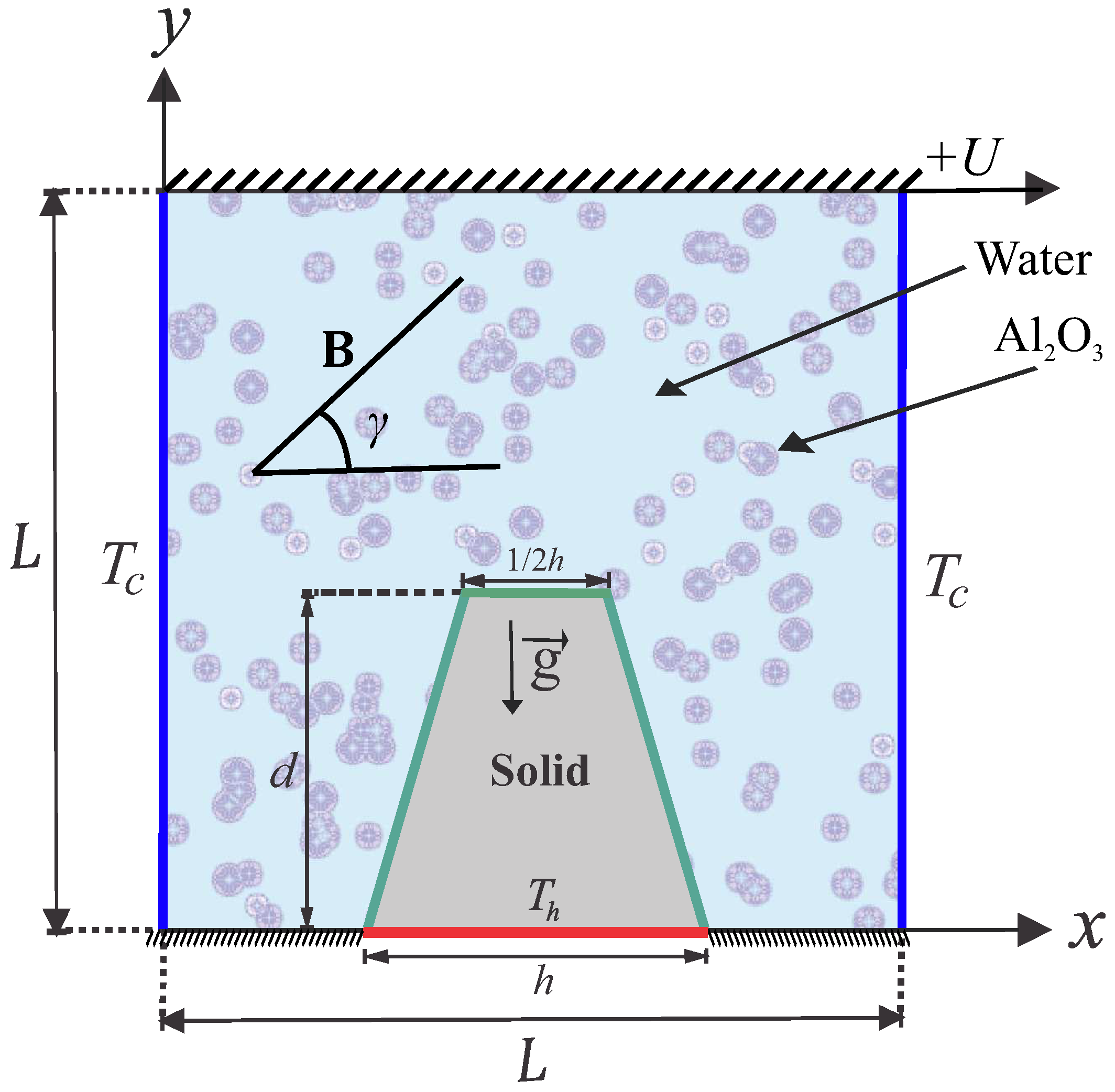

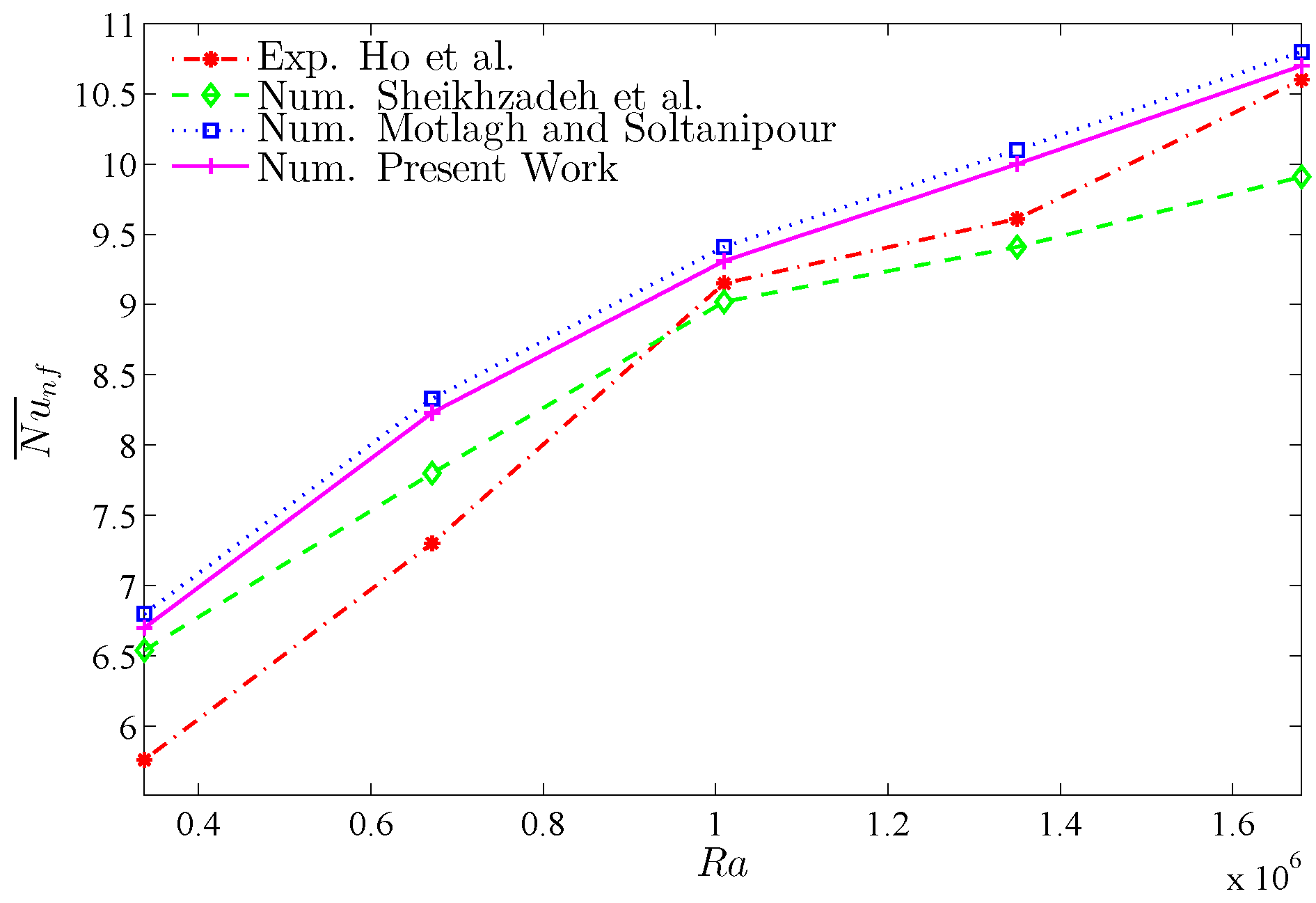




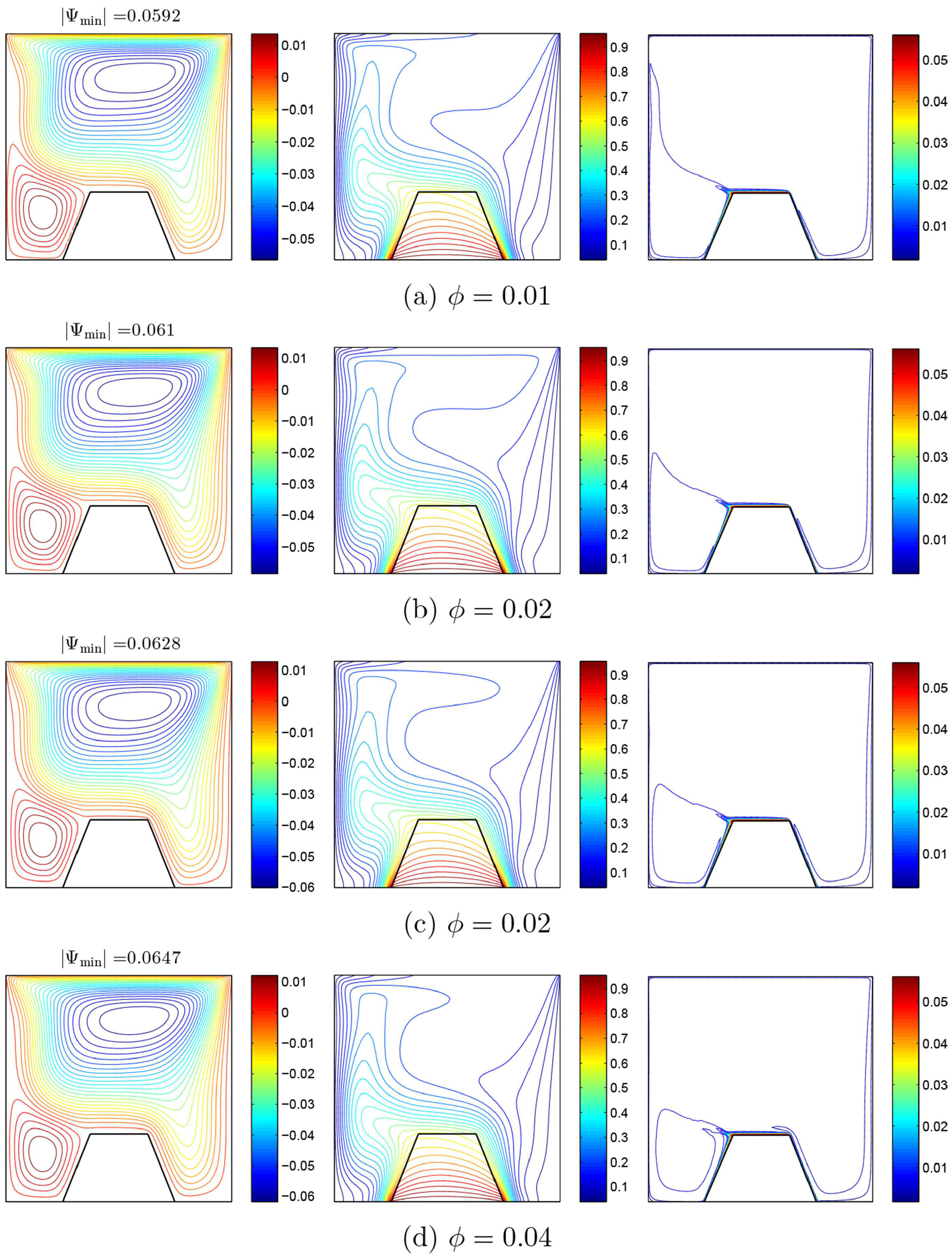
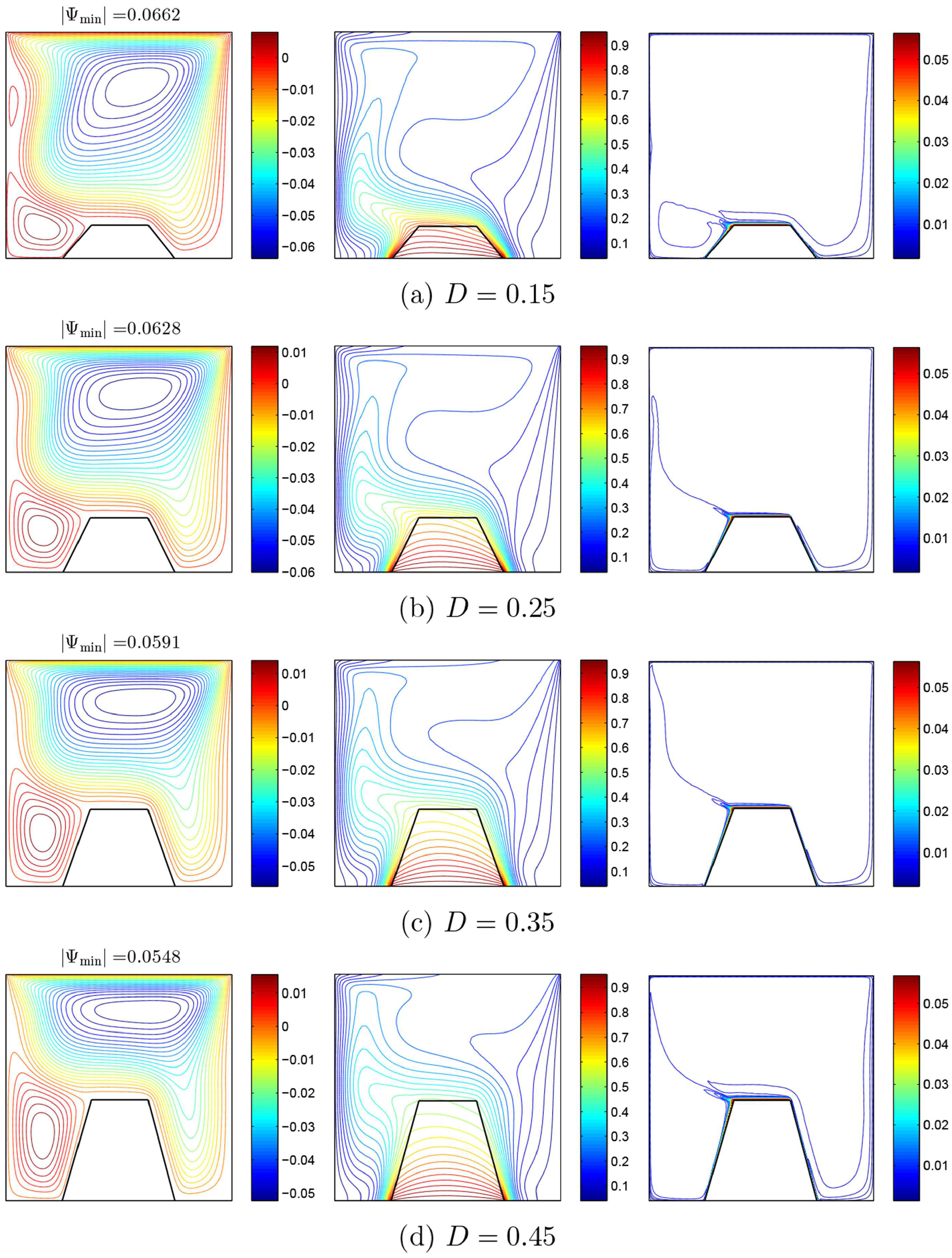





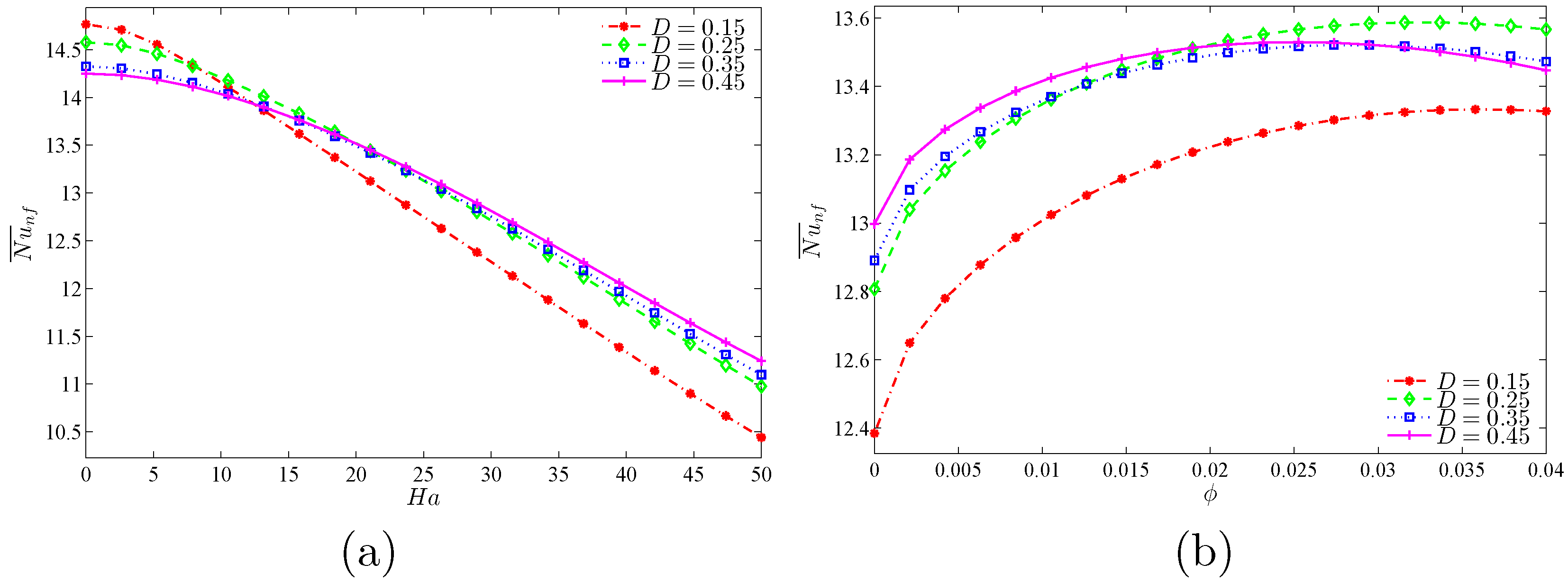
© 2018 by the authors. Licensee MDPI, Basel, Switzerland. This article is an open access article distributed under the terms and conditions of the Creative Commons Attribution (CC BY) license (http://creativecommons.org/licenses/by/4.0/).
Share and Cite
Sadiq, M.A.; Alsabery, A.I.; Hashim, I. MHD Mixed Convection in a Lid-Driven Cavity with a Bottom Trapezoidal Body: Two-Phase Nanofluid Model. Energies 2018, 11, 2943. https://doi.org/10.3390/en11112943
Sadiq MA, Alsabery AI, Hashim I. MHD Mixed Convection in a Lid-Driven Cavity with a Bottom Trapezoidal Body: Two-Phase Nanofluid Model. Energies. 2018; 11(11):2943. https://doi.org/10.3390/en11112943
Chicago/Turabian StyleSadiq, Muhammad Adil, Ammar I. Alsabery, and Ishak Hashim. 2018. "MHD Mixed Convection in a Lid-Driven Cavity with a Bottom Trapezoidal Body: Two-Phase Nanofluid Model" Energies 11, no. 11: 2943. https://doi.org/10.3390/en11112943





